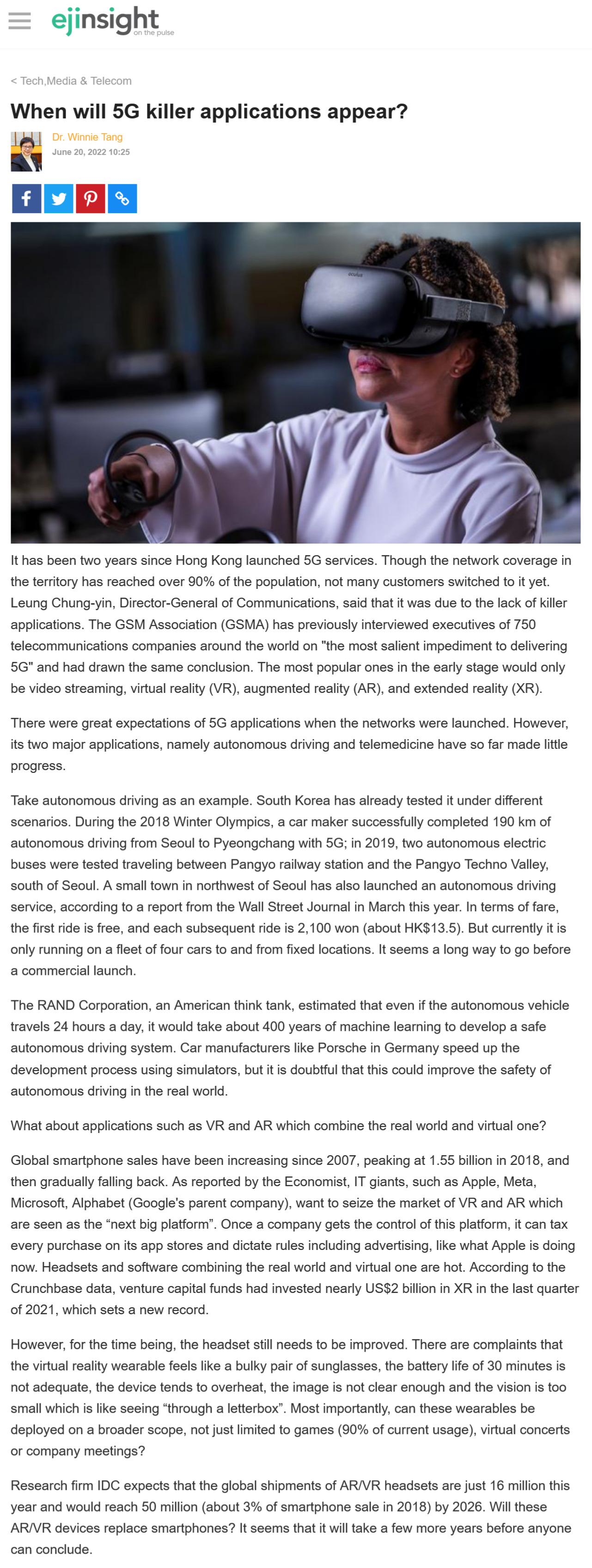網上版請按此

When will 5G killer applications appear?
It has been two years since Hong Kong launched 5G services. Though the network coverage in the territory has reached over 90% of the population, not many customers switched to it yet. Leung Chung-yin, Director-General of Communications, said that it was due to the lack of killer applications. The GSM Association (GSMA) has previously interviewed executives of 750 telecommunications companies around the world on "the most salient impediment to delivering 5G" and had drawn the same conclusion. The most popular ones in the early stage would only be video streaming, virtual reality (VR), augmented reality (AR), and extended reality (XR).
There were great expectations of 5G applications when the networks were launched. However, its two major applications, namely autonomous driving and telemedicine have so far made little progress.
Take autonomous driving as an example. South Korea has already tested it under different scenarios. During the 2018 Winter Olympics, a car maker successfully completed 190 km of autonomous driving from Seoul to Pyeongchang with 5G; in 2019, two autonomous electric buses were tested traveling between Pangyo railway station and the Pangyo Techno Valley, south of Seoul. A small town in northwest of Seoul has also launched an autonomous driving service, according to a report from the Wall Street Journal in March this year. In terms of fare, the first ride is free, and each subsequent ride is 2,100 won (about HK$13.5). But currently it is only running on a fleet of four cars to and from fixed locations. It seems a long way to go before a commercial launch.
The RAND Corporation, an American think tank, estimated that even if the autonomous vehicle travels 24 hours a day, it would take about 400 years of machine learning to develop a safe autonomous driving system. Car manufacturers like Porsche in Germany speed up the development process using simulators, but it is doubtful that this could improve the safety of autonomous driving in the real world.
What about applications such as VR and AR which combine the real world and virtual one?
Global smartphone sales have been increasing since 2007, peaking at 1.55 billion in 2018, and then gradually falling back. As reported by the Economist, IT giants, such as Apple, Meta, Microsoft, Alphabet (Google's parent company), want to seize the market of VR and AR which are seen as the "next big platform". Once a company gets the control of this platform, it can tax every purchase on its app stores and dictate rules including advertising, like what Apple is doing now. Headsets and software combining the real world and virtual one are hot. According to the Crunchbase data, venture capital funds had invested nearly US$2 billion in XR in the last quarter of 2021, which sets a new record.
However, for the time being, the headset still needs to be improved. There are complaints that the virtual reality wearable feels like a bulky pair of sunglasses, the battery life of 30 minutes is not adequate, the device tends to overheat, the image is not clear enough and the vision is too small which is like seeing "through a letterbox". Most importantly, can these wearables be deployed on a broader scope, not just limited to games (90% of current usage), virtual concerts or company meetings?
Research firm IDC expects that the global shipments of AR/VR headsets are just 16 million this year and would reach 50 million (about 3% of smartphone sale in 2018) by 2026. Will these AR/VR devices replace smartphones? It seems that it will take a few more years before anyone can conclude.
Dr. Winnie Tang
Adjunct Professor, Department of Computer Science, Faculty of Engineering; Department of Geography, Faculty of Social Sciences; and Faculty of Architecture, The University of Hong Kong